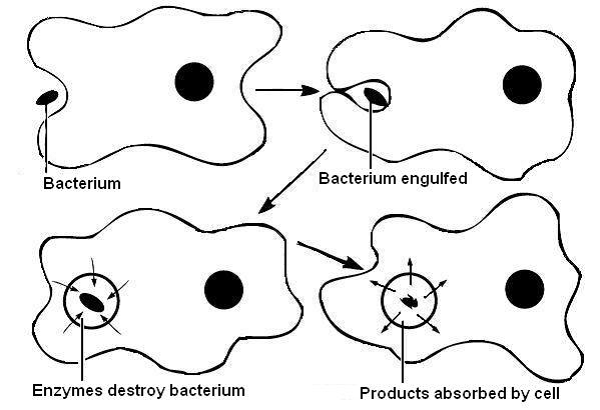Question #143c9
1 Answer
About phagocytosis.
Explanation:
Phagocytosis is a type of endocytosis. Endocytosis is a process through which a cell absorbs a particle, molecule, bacterium, or other type of matter by engulfing it. Phagocytosis refers to the engulfing of larger, solid particles. Often the engulfed particle is another cell, like when a white blood cell, which is a part of the immune system, engulfs a bacterium to destroy it.
Let's use the example of a white blood cell engulfing an invading bacterium to illustrate the process of phagocytosis. A cell that engages in phagocytosis is called a phagocyte. First, the white blood cell has to recognize the invader and realize that it needs to be destroyed. It recognizes signal molecules released by the bacterium and is drawn toward it.
The white blood cell then has to attach its membrane to the membrane of the bacterium. It does this by using molecules called surface receptors. These are molecules embedded in the white blood cell's membrane that are designed to detect and attach to molecules in the membrane of the bacterium. The two cell membranes link up and stick together.
Once attached to each other, the membrane of the white blood cell swells outward around the bacterium and engulfs it. The membrane enclosing the bacterium pinches off and the result is a little pouch, called a phagosome, that contains the offending bacterium inside of the white blood cell.
With the bacterium safely imprisoned inside the white blood cell, it can now be destroyed. The white blood cell brings digestive enzymes into the phagosome. These enzymes break up the bacterium and the resulting harmless particles can either be used by the cell or released out of the cell.
Just to remember: phagocytosis have his funny part.
Do you remember a game called "Pac-Man" ? So when Pac-Man opens his mouth and consumes one of the dots, it's a little bit like phagocytosis. :)
DETAILED PICTURE
 http://study.com/academy/lesson/phagocytosis-definition-process-types.html
http://study.com/academy/lesson/phagocytosis-definition-process-types.html


